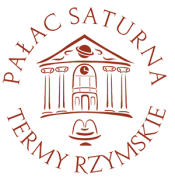The impressive, neoclassical palace is located in Czeladź at ul. Dehnelów 2. Currently, it combines the function of a conference centre, luxury suites, a business centre and a unique Roman Bath complex - the Temple of Health and Energy - a complex of saunas, baths and swimming pools.
Its large portico attracts a lot of attention. Based on four Ionic semi-columns, the tympanum presents the symbol of the mine - the planet Saturn. Above the semicircular balcony, there is a large clock decorated with figures of miners. A shield with a stylised letter "S" is inscribed in the key of the window arch. The building was raised around 1910, but it was initially much smaller (it was rebuilt in 1922-1923) and, as Marian Kantor-Mirski wrote in the 1930's, “it was the gem of the entire Coal Basin.” This building, with extremely intriguing architectural foundations, still fills us with admiration for its unique structure. A park stretches around the building. It was founded at the beginning of our century based on a design by S. Cielichowski. It covers an area of 1 hectare. The path system of the park was completely blurred, and most of its layout was destroyed along with the greenery.
Today, thanks to the efforts of the present owner, the building has regained its former glory. Renovation and illumination of the historic façade were performed. The stylish fountain, which was placed in front of the main entrance to the building, adds unusual character to it. The main entrance is guarded by two powerful lions leaning against the symbolic 'S'. The new car park and the newly paved driveway in front of the building have made it even more attractive.
Here the office of the Saturn Society was located, and then the management office of the Saturn coal mine, the beginning of which dates back to 26 January 1869, when the presbytery estate was sold by the Russian government to an advocate from Warsaw, Ludwik Kozłowski.

Around 1872, Mr Kozłowski began searching for hard coal on his property and managed to find coal seams located 122 meters underground thanks to drill holes. Two years later, however, he sold the property to prince zu Hohenlohe-Oehringen. The prince continued coal exploration and reached more efficient deposits around the year 1880. In 1887, the first exploitation level was set up at the depth of 150 m and the mine reached the capacity of 2,600 tonnes. In the following years, production increased rapidly, reaching 400,000 tonnes in 1898. The mine received pumps and hoisting machines with steam propulsion, and at that time employed 1,160 people, of which 887 were working underground.
On 1 April 1899, prince zu Hohenlohe-Oehringen sold the mine to the Mining and Industry Society "Saturn" founded by industrialists from Łódź: Karol, Emil and Anna Scheibler, Alfred Biedermann, Julian Heinzl, Julian Kunitzer, Edward Herbst and Stanisław Reicher from Sosnowiec. The purchase of the mine was related to the fact that the owners of the largest textile factories in Łódź wanted to have their own fuel supply in order to protect themselves against the price increase by the Basin’s mining entrepreneurs. The "Saturn" Society, whose shares were owned by Polonised industrialists of German origin, was one of the few companies in the Coal Basin with domestic capital. Its Management Board was initially based in Łódź and it was not until 1906 that it was moved to Czeladź. The first President of the "Saturn" Society was an outstanding engineer Hieronim Kondratowicz. In 1906 he resigned as President and was appointed to the board of directors of “Saturn”. His place was taken by Alfons Surzycki, but the technical management of the mine was entrusted to its former manager, engineer Brzostowski. The company was developing successfully, showing great profits until WW1.


